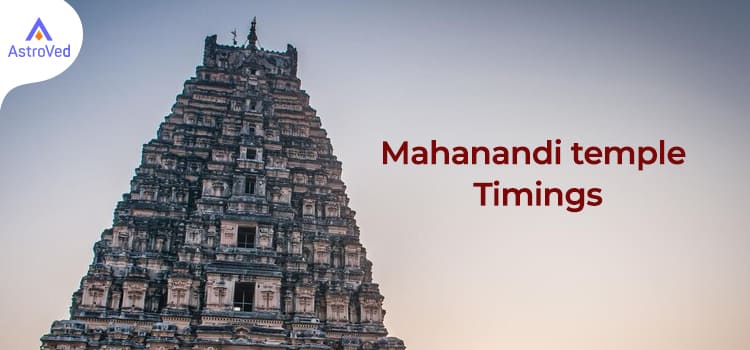Mahanandi (Maha Nandi) Temple refers to the Mahanandiswara Swamy Temple located in the Mahanandi village in the Nandyal District of Andra Pradesh state. The village is about 20 km from Nandyal town and lies to the east of the hills of Nallamala, surrounded by forests.
‘Nandi’ is the Bull Mount of Lord Shiva, and ‘Maha Nandi’ means the great Nandi vehicle. This region is famous for 9 such Shiva shrines ending with the term Nandi, known as Nava Nandulu, and the Mahanandi Temple of Mahanandiswara Swamy is one of them. All these 9 shrines are within a radius of about 15 kilometers.
Mahanandi Temple Legend
There is an interesting legend about the origin of Mahanandi Temple. A cowherd who used to take the cows for grazing in these forests found that a particular cow entered a bush daily, drained its milk in it, and returned completely empty. When he followed the cow, hid nearby, and observed closely, he saw, to his surprise, that the cow stood where the grass had covered an anthill, from which a young man came out and drank the milk. Initially, the cowherd could not believe his eyes, but when the same incident repeated, he could not resist sharing the happening quietly with a few people.
Soon, the matter reached the king of the place through his spies, and the next Day, the king himself followed the cow silently to know the truth. But the cow somehow sensed his presence, got frightened, and ran away quickly from that place. In the process, one of its hoofs sank into that hole as it took to its heels, and the lad also disappeared from the scene.
As the king hovered between wakefulness and sleep that night, thinking about what he saw that day, Shiva appeared in his dream and revealed that it was only he who was drinking the cow’s milk and instructed the king to build a Temple at that place. When the king went to that spot the next Day and peeped into the anthill, what he saw there was a Lingam-shaped rock formation, with the marking of the cow’s hoof on it.
Grateful that God chose him for that Divine purpose, he constructed the Shiva Temple there around the Shiva Lingam, arranged for digging a big pond nearby inside, and built 2 more ponds on the north and east of the Temple outside. The big pond in the Temple became the Rudra Kunda, and the other two became the Brahma and Vishnu Kundas.
Hence, Mahanandiswara Swamy, the presiding deity of the Mahanandi Temple, is in the Linga form, which people believe to be Swayambu, the self-manifested.
Mahanandi Temple History
Mahanandi Temple is an ancient structure dating back to more than 15 centuries. The Badami Chalukyas raised the initial structure in the 7th century CE, and the Temple has seen many repairs, renovations, expansions, and additions, subsequently, around the 10th and 15th centuries. The Temple has stone tablets from the 10th century that speak about the Temple getting repaired and rebuilt many times. While Vimana, the spire above the sanctum, is in the architectural style of the Badami Chalukyas, the other structures of the later times are of the Vijayanagara style.
According to some views, the kings who ruled this region in and around the 10th century were known as the Nandas, whose ancestral deity was Nandi. They built many temples and worshiped Shiva and Nandi; Mahanandi was one of them.
Mahanandi Temple Structure and Architecture
The Mahanandi Temple is well-known for its freshwater ponds, known as Pushkarni or Kalyani. While the Temple architecture has the unmistakable stamp of the Chalukya and Vijayanagara styles, the Temple ponds remain examples of the Vishwakarma skills.
Of the 3 ponds, the big one is inside the Mahanandi Temple itself. It is about 60 square feet in area and has a Mandapa (pavilion) at the center. The water level is balanced so that it always remains at 5 feet, enabling devotees and pilgrims to have a holy dip in it.
This water originates in the sanctum, where it flows from underneath the self-manifested Linga, the presiding deity of the Temple. This water flow remains constant, whether it is summer, monsoon, or winter. Devotees can feel this water with their hands in the sanctum itself near the Shiva Lingam. They can also touch the Lingam and offer prayers to it, which can be called a unique feature of this Temple. Because devotees usually cannot touch the deities in the Temples and are required to stay away from them.
The holy water of this pond is celebrated for its crystalline and healing properties. The peculiarity also rests on the fact that the water is always tepid; it becomes hot during winter and relatively cooler in summer. Similarly, the water that is lukewarm early in the morning starts cooling down as the temperature rises during the Day. The water flowing from the tank irrigates around 2000 acres of land around the village.
A grand celebration takes place in the Mahanandi Temple during Maha Shivaratri, which is regarded as highly holy for Shiva worship and lasts seven days. Thousands of devotees from all over Andra Pradesh visit this Temple daily, as well as the neighboring states of Telangana, Tamil Nadu, Karnataka, and Maharashtra, to seek Divine blessings.


